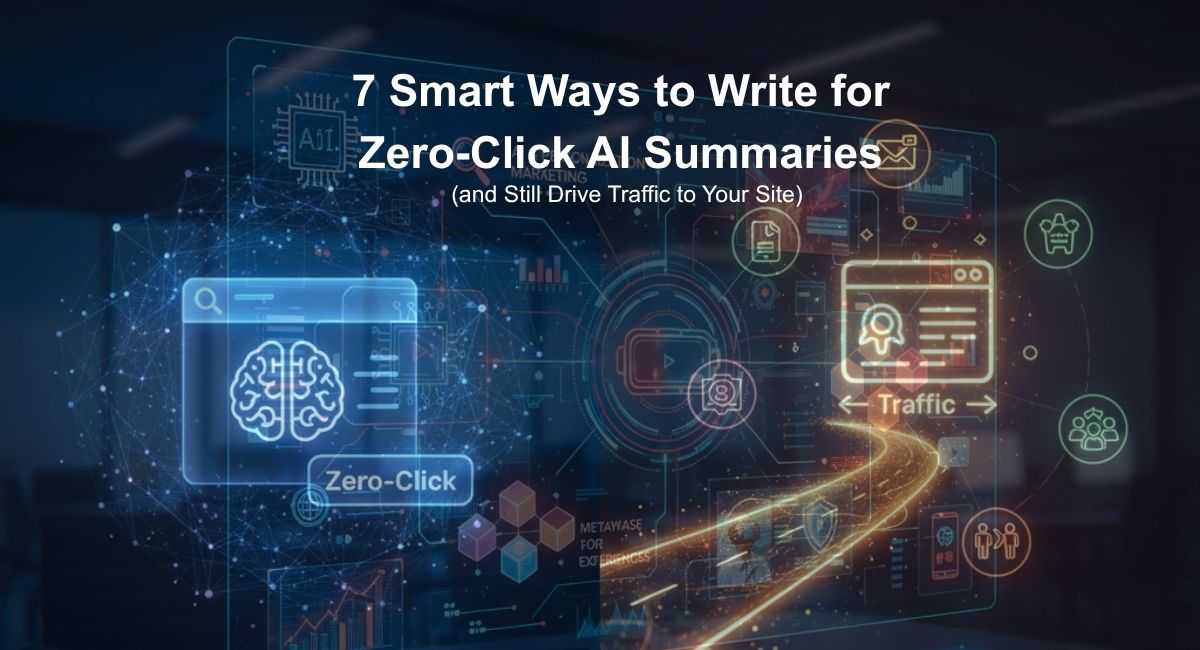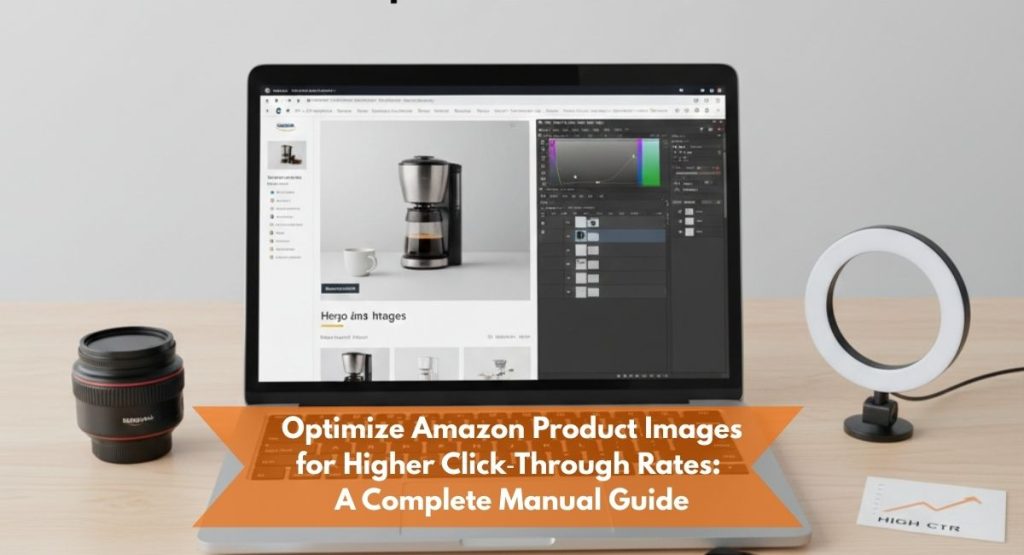Search is evolving faster than most businesses can keep up with. Google, Bing, and platforms like Perplexity are rolling out AI-powered summaries that deliver instant answers at the top of search results. These “zero-click searches” are designed to help users by reducing the number of steps needed to find information. But for content creators, marketers, and business owners, they raise a serious question: what happens when people no longer click on your site?
The truth is, zero-click summaries don’t mean your content loses value. They mean your strategy must change. Just as Generative Engine Optimization is shifting the rules of visibility, writing for AI summaries requires balancing two priorities: giving AI the clarity it needs while giving users reasons to visit your site for more.
This manual guide explores seven smart ways to write for zero-click AI summaries and still drive meaningful traffic. Along the way, we’ll break down practical techniques, show examples, share tables, and answer key FAQs about this new search era.
Why Zero-Click Summaries Matter for SEO
Zero-click results are not new. Featured snippets, answer boxes, and knowledge panels have been reducing clicks for years. The difference now is scale. AI overviews pull content from multiple sources, weave it into a conversational answer, and present it directly on the search results page.
For businesses, this introduces two challenges:
- Visibility without clicks: Your content may appear in an overview but still not drive traffic.
- Authority versus engagement: AI can cite your site, but readers may not explore further unless you give them a reason.
That doesn’t mean the game is lost. Smart publishers and businesses can still:
- Position themselves as trusted sources cited in AI overviews.
- Structure content to create curiosity gaps that draw clicks.
- Offer unique assets that cannot be summarized by AI.
In short, the path forward is adaptation, not resistance.
1. Write With Structured Clarity and Depth Beyond the Summary
AI models prefer clean, structured text. They parse headings, bullet points, and concise definitions far more easily than long, winding paragraphs. If your content is formatted clearly, it has a higher chance of being cited in summaries.
But here’s the catch: if you stop at clarity, AI will give users everything they need. That means no clicks for you.
The solution is balance. Start with clear answers, then expand into depth AI cannot fully capture.
Example:
If covering “AI summary SEO best practices,” begin with a short definition:
“AI summary SEO best practices are strategies that optimize content for AI-generated overviews while ensuring the site still earns traffic and authority.”
Then expand with frameworks, examples, case studies, and data that make your article richer than any summary.
This layered depth creates citability for AI and curiosity for readers.
2. Place Contextual Hooks After Concise Answers
Readers are skimmers by nature, and AI summaries encourage that behavior. To counter this, use contextual hooks: sentences placed right after a concise answer that hint at deeper insights.
Instead of writing:
“Zero-click summaries provide answers without a site visit.”
Write something like:
“Zero-click summaries provide quick answers, but they rarely explain how content creators can adapt strategies to keep attracting readers. That’s where the real opportunity lies.”
This approach acknowledges the user’s immediate need but signals that your site holds the complete story. Think of it as giving readers a taste, not the entire meal.
3. Use Tables and Visual Data That AI Cannot Fully Replicate
One of the smartest ways to outmaneuver AI summaries is by offering assets they cannot replicate. While text is easily scraped and paraphrased, tables, frameworks, and original visuals are much harder to present accurately in a summary.
Here’s an example table comparing writing strategies for zero-click environments:
| Writing Approach | How AI Uses It | Why Readers Still Click |
| Short definitions | Summarized in overview | Readers want context and real-world uses |
| Step-by-step lists | Displayed in snippets | Readers want expanded explanations |
| Data tables | Often partially extracted | Readers click for full view and accuracy |
| Case studies | Rarely summarized well | Unique storytelling only on your site |
This simple framework shows how formatting decisions impact both AI inclusion and traffic retention. By embedding such elements, you give readers a reason to leave the summary behind and explore your site.
4. Focus on Long-Tail and Conversational Queries
Zero-click summaries dominate broad, generic queries like “what is SEO” or “how does AI search work.” But AI struggles with niche, long-tail, and conversational questions.
For example:
- “How to rank in SERP with no clicks in 2025”
- “Best ways for publishers to avoid traffic loss from AI summaries”
- “Writing strategies for AI-powered search engines”
These types of queries are more likely to surface your content directly and send clicks your way.
By combining long-tail keyword targeting with AI search optimization, you improve your chances of visibility in both AI summaries and organic results.
5. Create Content That Offers More Than Words
Text alone risks being fully summarized by AI. To stand out, your content must offer value beyond words. This can include:
- Downloadable resources like SEO checklists or content templates.
- Original research that AI cannot fabricate.
- Interactive tools such as ROI calculators or audit generators.
- Case studies and stories that require full context to appreciate.
For example, a guide on technical SEO could include an interactive site audit template. AI might summarize the concept, but users will still need to visit your site to access the tool.
This strategy ensures your page remains indispensable, even when summaries capture the surface-level answer.
6. Optimize Metadata and On-Page Elements for AI and Humans
Even in an AI-driven search world, metadata and formatting remain powerful levers. AI uses schema markup, structured lists, and headings to interpret your page.
To maximize your chances of being cited:
- Add schema markup for FAQs and how-to content.
- Use keyword-rich but natural headings.
- Keep introductions concise but compelling.
- Structure key points in bulleted lists.
Pairing this with our strong on-page SEO services ensures both machines and humans see your content as authoritative and scannable.
7. Interlink Strategically to Build Topical Authority
Zero-click summaries may reduce external clicks, but once users land on your site, you must keep them engaged. Internal linking is one of the best tools here.
When writing about “how to rank in SERP with no clicks,” you can link naturally to:
- Generative Engine Optimization for a deep dive into future search strategies.
- AI SEO services to explore how businesses adapt.
- SEO strategy insights for advanced planning.
This approach strengthens your semantic network and builds trust with AI systems while encouraging readers to explore more of your expertise.
Manual Guide: Step-by-Step Summary
Here’s a quick reference table to turn these strategies into action:
| Step | Practical Action | Benefit |
| 1 | Provide concise definitions + depth | Cited in AI summaries and still click-worthy |
| 2 | Add contextual hooks after answers | Creates curiosity gaps for readers |
| 3 | Include tables and visuals | Makes content harder to summarize fully |
| 4 | Target long-tail queries | Less competition, more traffic potential |
| 5 | Offer unique assets | Adds value AI cannot replace |
| 6 | Optimize metadata and schema | Boosts visibility in AI overviews |
| 7 | Use internal linking | Builds topical authority and engagement |
Frequently Asked Questions
What is a zero-click AI summary?
It’s a generated result that answers a query directly on the search page, reducing the need for users to click through.
How do I optimize content for AI overviews?
Write with structured clarity, use question-based subheadings, apply schema markup, and provide assets AI cannot summarize.
Will AI summaries replace organic SEO traffic entirely?
No. They change the flow of traffic, but businesses that balance concise answers with unique on-site value will still attract visits.
What content type is hardest for AI to summarize?
Case studies, interactive tools, data tables, and templates are less replicable and drive readers to the source.
Is GEO replacing SEO?
Not fully. GEO vs SEO will remain a core debate, but both strategies are essential for future visibility.
Final Thoughts
Zero-click AI summaries represent a shift, not a death sentence for traffic. Businesses that adapt their content will thrive by positioning themselves as sources of authority for AI systems while also offering unique value that drives clicks.
The key is not to fight AI summaries but to write for them strategically. Structured clarity gets you cited. Depth, hooks, visuals, and assets get you clicks. Internal linking keeps readers engaged.
If you’re ready to future-proof your digital presence and build strategies that balance AI-driven search with human engagement, Maxim Blu offers customized SEO, content, and web development services that help brands stay visible and competitive in this new landscape.





